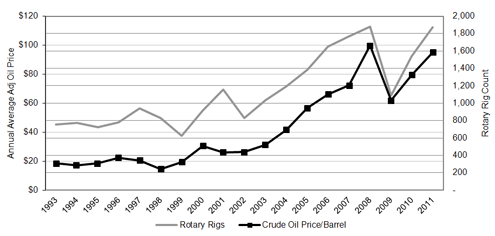OIL AND GAS EXTRACTION

Input: Economic Factors
Activity in the Oil and Gas Extraction Subsector is driven by multiple international factors. Oil prices have ranged from less than $15 to over $100 per barrel during the last decade. These fluctuations in prices are due to changes in supply as controlled by many private, national, and international organizations, as well as government stability and issues with refining and delivering petroleum products. High prices can increase the viability of small drilling companies and increase interest in maintaining existing wells.
Figure 1: Annual Average Crude Oil Price and Number of Active Oil and Gas Rigs, 1993-2011

Sources: Crude oil price – Energy Information Administration, Department of Energy; Rig Count – Baker Hughes Inc. (1993-2011 Sum of annual average for Active Rotary Rigs for the United States).
Drilling activity can be measured by the number of active rotary rigs. Drilling activity is associated with the price of the commodity involved (Figure 1) and varies over time, having a direct effect on the industry. The United States is currently experiencing an increase in oil prices, which corresponds with an increase in the drilling activity occurring both on-land and off-shore.
Improvements in technology can decrease the number of workers required to drill a well, but these improvements require capital investments in equipment. During 2003-2010 the number of workers in this industry grew 48% from 293,000 to 435,000 (Quarterly Census of Employment and Wages). Shortages of trained workers in this industry has led the Department of Labor to award several grants to specific oil and gas training facilities in the Western United States: Midland College in West Texas; San Juan College in Farmington, New Mexico; and the High Plains Technology Center in Woodward, Oklahoma.
Sources
Baker-Hughes North American Rig Count
Historical Crude Oil Prices , Energy Information Administration, Department of Energy
Quarterly Census of Employment and Wages , BLS, Department of Labor
Disclaimer: Mention of any company name or product does not constitute endorsement by the National Institute for Occupational Safety and Health for the content of these Web sites.
Previous Page: Sector Description Next Page:Occupational Risks
- Page last reviewed: March 19, 2012
- Page last updated: March 19, 2012
- Content source:
- National Institute for Occupational Safety and Health Western States Office


 ShareCompartir
ShareCompartir